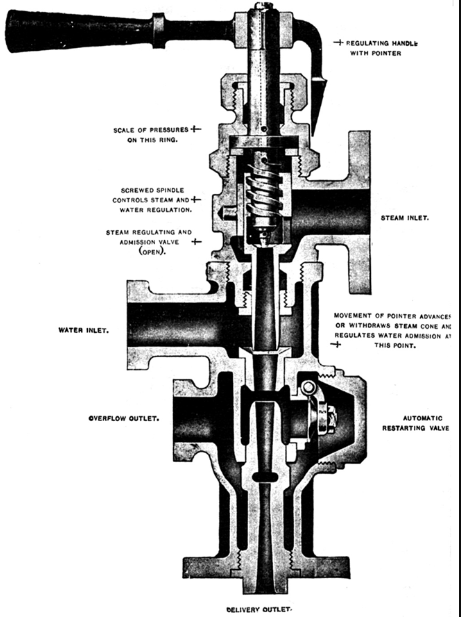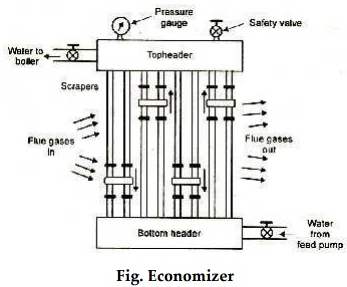UNIT 6
Steam Generators & Boiler Draught
These are the devices used for burning of fuels to produce flue gases which in turn heat up the water to produce steam that can be used to produce mechanical power in steam turbines.
Desirable properties of boilers:
The boilers are classified on many criteria such as:
- Stationary boilers. E.g.: Lancashire, Babcock and Wilcox
- Portable boilers. E.g.: Locomotive
- Low pressure boilers: Can generate pressure upto 10 bar. E.g.: Cochran
- Medium pressure boilers: Can generate pressure between 10 to 25 bar. E.g.: Lancashire
- High pressure boilers: Can generate pressures above 25 bar. E.g.: Babcock and Wilcox
- Horizontal boilers. E.g.: Lancashire
- Vertical boilers. E.g.: Cochran
- Forced circulation: Makes use of pump for feeding water.
- Natural circulation: Makes use of natural circualtion of water.
- Fire tube boilers: Flue gases pass through tubes and water is in the main shell.
- Water tube boilers: Water passes through tubes and flue gases pass over these tubes in the main shell.
- Externally fired: The furnace is separately placed than the main boiler body.
- Internally fired: The furnace is placed within the main body of the boiler.
Lancashire boiler:
This is a horizontal, stationary fire tube boiler. It is an internally fired boiler. It produces low pressure steam and uses natural circulation.
It consists of a large drum of diameter around 4-6 m and length around 8-9 m. There are two fire tubes present in the boiler which take up almost 45% of the cross-section area. The flue gases pass through these tubes. Water is in the surrounding drum. Due to the heat exchange by convection over the tubes, water is heated and converts into steam at low pressure.

Babcock and Wilcox Boiler:
This is a water tube, stationary boiler. The water passes through the metal tubes and the flue gases coming from the grate of the furnace pass over these tubes.
This results in heating of water and conversion into steam. Steam is collected in the drum where bottom half is filled with water.
Baffles are used to create turbulence in flow of flue gases within the shell of boiler to make the process more efficient.
The water used in this boiler needs to be treated before feeding since water is going to be converted into steam in the tubes. Presence of any impurities in such case can cause blockage of the tubes.

Boiler Mountings:
Boiler mountings are integral parts of boilers and are required for proper functioning of the boilers.
Let us see various mountings.

2. Pressure gauge: It is fitted in front of the boiler to make it easier for the operator to monitor the pressure readings. A bourdon gauge is most commonly used for this purpose.

3. Safety valves: These are located on the top of the boiler. They guard the boiler against dangerous excessive steam pressure in the drum. If the pressure exceeds the preset value, then the valve unseats and blows off the steam until the pressure is brought to acceptable level. The most commonly used type of valve here is spring loaded safety valve.

4. Fusible plug: It is an important mounting in fire tube boiler. It is fitted just above the furnace. It protects the boiler against overheating. It has gun metal plug fixed in gun metal body with a fusible molten material.
Under normal conditions, the fusible plug is immersed in water and the device is safe against melting. But if there is not sufficient water in the boiler, the fusible plug is exposed and due to excessive heat, the plug melts. The water and steam rush through the cavity that is created and extinguish the flame.

5. Blow-off cock: This is mounted in the bottom-most part of the boiler. It allows to drain off any deposition of impurities like mud and sediments as well as to drain off water to clean the boiler.

6. Feed check valve: It is fitted just below the working level of the boiler. The function of feed check valve is to supply high pressure water to the water and also avoid the return flow in case of pump failure.

7. Stop Valve for Steam: It is located on topmost part of steam space. It is used to regulate the supply of steam from the boiler to turbine.

Boiler Accessories:
The various accessories that are used in the boiler are listed below:

3. Economizer: It is basically a water preheater. The flue gases that are let off from the boiler are passed over the economizer tubes to heat the feed water. This increases the temperature of water entering the boiler and improves the thermal efficiency of the boiler.

4. Superheater: It is located after the primary heating arrangement in the boiler. It is useful for heating the steam produced in primary heat transfer circuit above the saturation temperature of steam. Hence it produces superheated steam which increase the efficiency of the turbine.

5. Air preheater: The air that is supplied to the furnace grate is preheated in this device. This results in lesser consumption of coal and increases the overall efficiency of boiler. Hotter air makes it easier to burn the coal.

It was introduced in 1950. The act has specified various criteria and conditions that should be met by the manufacturers of boilers. Failing to do so can result in severe legal and penal actions. Manufacturers and suppliers of boilers and associated components must comply with the Indian Boiler Regulations if those items are used in India. The boiler construction has to be under the supervision of an Inspecting Officer and must be inspected at all stages of construction.
Advantages of IBR Boilers:
The performance of boiler is measured in terms of its capacity of steam production. However, for comparing two boilers, both should have same temperature of feed water, same pressure, same fuel and same exhaust condition of steam. These conditions cannot be exactly same for all boilers. Hence, some standards are set.
The feed temperature is usually set to 100°C. The working pressure is set as normal atmospheric pressure, i.e., 1.033 kg/cm².
Equivalent Evaporation
The amount of water evaporated from 100°C and converted into dry saturated steam at 100°C is called as equivalent evaporation.
Since the water is already at 100°C, it needs only latent heat of vaporization to convert into steam. It is 2257 kJ/kg.
So , E= total heat required to convert feed water into steam / 2257
Let, t1 = Temperature of feed water,
h1 = Sensible heat of feed water in kJ/kg of steam corresponding to t1°C,
H = Total heat of steam in kJ/kg of steam at a given working pressure
H = h + xL (For wet steam having dryness fraction x)
H = h + L (For dry saturated steam)
H = h + L + Cp (tsup - tsat) (For superheated steam)
We = Weight of water actually converted to steam (kg/hr or kg/kg of fuel burnt.)
We know that heat required to convert 1 kg of water to 1 kg of dry saturated steam = H - h1
∴ for total weight of water to be converted to dry steam, heat required = We (H - h1)
And E = We (H - h1) / 2257
Boiler efficiency
It is defined as the ratio of heat required to produce steam to calorific value of fuel.


Heat Losses in a Boiler
Following losses occur in the boiler:
∴ Boiler efficiency = 100 – (L1 + L2 + L3 + L4 + L6 + L7 + L8).
A proper analysis of heat supplied per kg of dry fuel and amount of heat utilized is shown by a heat balance sheet.

The draught is necessary for circulation of air effectively over the furnace grate to make sure that there is a complete combustion of coal to produce maximum flue gases and also for carrying the products of combustion out of the system.
For this, there is a need of pressure differential. This pressure difference is creating with the help of draught.
Types of Draught
Limitations:
2. Artificial Draught: The draught required for the flow of flue gases is created by some external agency. There are three types of artificial draughts.
Advantages of Artificial Draught:
Limitations of Artificial Draught:
Size of chimney:
Let m kg be the air supplied for every kg of fuel being burnt. ∴, (m+1) kg flue gases will be created.
Let To be the absolute temperature corresponding to 0°C, T1 be the absolute temperature of atmospheric air and T be the absolute mean temperature of the flue gases.
The difference of pressure of cold air and hot flue gases, the height of the flue gases is equal to the height of the chimney H metre results in the natural draught
1 kg of air occupies 0.7734 m3 at normal conditions. Let H m be the height of a chimney measured from grate level and h mm be column of water which will be balanced by a draught
Mass of products of combustion per kg of fuel are (m + 1) kg. Volume of air per kg of fuel burnt will be 0.7734 m3 at T Kelvin. It is also equal to the volume of flue gases per kg of fuel at T K.
Volume of m kg of air, at T1 temperature = 0.7734 m x T1 / To m3
As the pressure difference is small, the calculations can be carried out by Charles' law,
Volume of (m + 1) kg of flue gases at T Temperature = 0.7734 m x T / To m3
ρ = Density of air at T1 temperature = mass / volume = m T0 / (0.7734 m x T1)
ρ = T0 / (0.7734 x T1) = 1.293 T0 / T1 kg / m3
Similarly, density of chimney gases at T temperature
ρT = 1.293 (m+1 / m) x T0 / T
The total pressure difference P N/m2, which is due to the difference in the weight of hot flue gases inside the chimney which is H metre high and acting on A m2 area and a column of the atmospheric cold air of same area and height.
P x A = (H x A x ρT1 - H x A x ρT) x g.
ρT1 = density of air at T1
ρT = density of air at T
On substitution of values for the densities, we get
P = Hg (1.293 T0 / T1 - 1.293 (m+1 / m) x T0 / T)
= Hg x 1.293 x T0 (1/T1 - [m+1 / m] / T) Pa
= 353 Hg (1/T1 - [m+1 / m] / T)
Height of water column h = P / ρg
If h mm be the draught measured in water column,
Then, h = 353 H (1/T1 - [m+1 / m] / T)
Let H' be the height of a column of hot gas in metre which would produce the pressure P N/m2
H’ = P / (ρg x g)
Where, ρg = density of hot gases.
Substituting the value of P from above equation
H’ = H ([m+1 / m] x T / T1 - 1)
By all usual notations used above, the condition for maximum efficiency is given by
